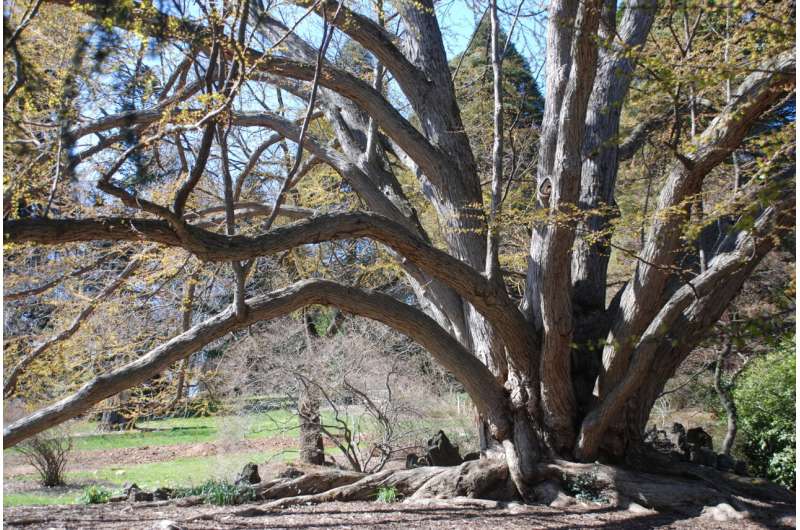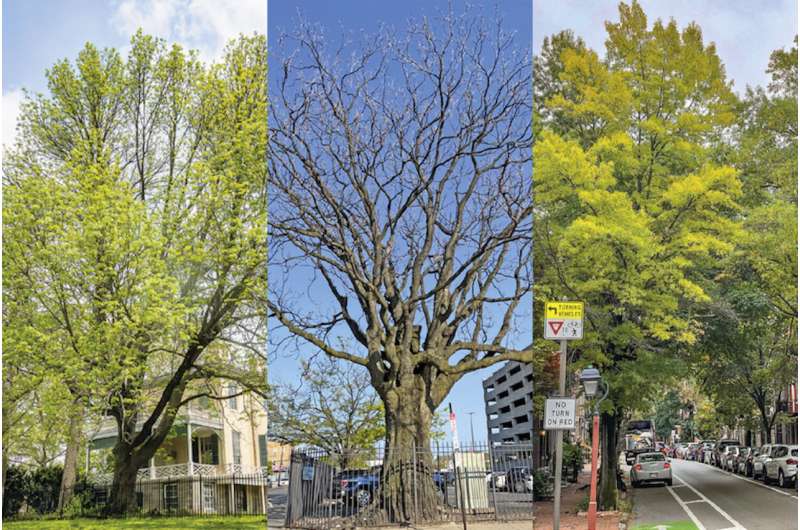An icon at Morris Aboretum, a many-trunked katsura tree is among those specimens featured in “Philadelphia Trees.” It was planted in the early 1900s. Credit: Paul W. Meyer
Asked to name his favorite tree, Paul W. Meyer, the former director of Penn's Morris Arboretum, likens the task to "asking a parent to name their favorite child."
Hedging, Meyer cites Morris' iconic and sprawling katsura tree but also shares his admiration for a giant American sycamore growing on the east side of Philadelphia's Washington Square. "It's actually growing on a sidewalk," Meyer says. "It's an enormous tree that should no longer be alive by all objective measure. But it's just thriving."
Such impassioned feeling for trees is woven through the pages of "Philadelphia Trees," a field guide originally published in 2017 and updated and republished this year by the University of Pennsylvania Press. Meyer coauthored the pocket-sized, 280-page work with Catriona Bull Briger and Edward Sibley Barnard.
The book is broken into three major sections: one on some of the top tree-watching locations in greater Philadelphia, another profiling 50 notable trees in the region, and a field guide including 168 species to help readers identify the trees they're most likely to encounter locally. The book also includes a brief history of Philadelphia's "arboreal heritage," authored by Penn alum David Hewitt; a quick reference guide to trace trees to their taxonomic groups in the book's inside cover; more than 1,000 color photographs, maps, and line drawings; and a bibliography.
"The book is meant for a general audience, someone like me who is interested in trees but may not know the difference between a black oak and a red oak," Barnard says. "It's intended to be very readable and accessible."
Inspired by city trees
Barnard has had a lengthy career in publishing. After retiring from Reader's Digest, he developed a greater interest in natural history. On a walk home through New York's Riverside Park, he tripped on some fallen sour gum balls and inspiration struck. He got to work on what would become "New York City Trees," first published in 1999 by Columbia University Press in collaboration with the city's Department of Parks and Recreation and the New York Tree Trust.
In 2010, Barnard moved to Philadelphia's Chestnut Hill neighborhood to be closer to his grandchildren and met Meyer, who proposed creating a similar tree resource for Philadelphia. The two enlisted the help of Briger, who has a background in landscape architecture as well as writing and design, and together went about identifying, photographing, mapping, and writing about some of the most impressive trees and tree-viewing sites in the city.
The group went on such missions over the course of several years to craft "Philadelphia Trees," originally published by Columbia University Press in partnership with Morris Arboretum. The selection of included sites and trees was guided by the expertise of Meyer as well as Hewitt, who has a background in botany and has written extensively about Philadelphia's trees; Joel Fry, curator at Bartram's Garden; and Ken LeRoy, a knowledgeable local arborist.
"During those years when we would go out on these tree walks and afternoon expeditions, you'd feel a little bit like an explorer or a detective," Briger says
The authors visited sites all across Greater Philadelphia to identify particularly impressive trees. Among those that caught their attention: a white oak at Lemon Hill, an ailanthus in North Philadelphia, and willow oaks in Society Hill. Credit: Paul W. Meyer (right and left), Edward Sibley Barnard (center)
In the five years since the book was initially printed, much has changed in the arboreal world of Philadelphia, and the trio of authors decided during the pandemic that it was time to refresh their publication. They worked with Penn Press to do so, again in collaboration with the Morris Arboretum.
"When you're focusing on big, old, mature trees, they're much more at risk than a young tree," says Meyer, meaning some of the trees highlighted in the first edition were no longer living.
One example is the famous Philly tree depicted on the cover of the first edition: a stately sugar maple at Belmont Plateau. To much ado, the city removed that tree, which was ailing, in 2021, planting in its place a stand of black gums, whose vibrant fall color rivals that of the maple.
Briger notes additional losses sustained at the arboretum of Temple University Ambler. "In 2021 there was a tornado, and they lost something like 75% of their trees," she says.
As a result, Barnard, Meyer, and Briger returned to each of the sites they had listed in the first edition, some visits leading to wholesale rewrites of those sections.
Special trees, close to home
Penn's campus receives its own dedicated section in "The Best Places to See Trees" section of the book, the authors drawing attention to the Treaty Elm that foregrounds College Hall, the Japanese zelkovas that line Locust Walk, the southern magnolias near the Wistar Institute, and the diverse collection of species in James G. Kaskey Memorial Park, not to mention the fact that the campus itself is a designated arboretum.
Morris Arboretum, likewise, is called out as a site of interest, with a tree map, designed by Briger, orienting readers to 23 trees of note. Another dedicated map calls out 26 notable trees mere steps from Penn's campus at the Woodlands Cemetery, the former estate of plant collector William Hamilton.
Overall, the authors express a desire for their book—designed to be slim enough to slip easily into a pocket or bag—to empower people with the knowledge to better understand the plants around them and develop a deeper appreciation for their value to the landscape, to the environment, to our health and well-being, and to future generations.
"Most people walk around in this world looking at a green haze. They're not actually seeing plants. They're not actually seeing trees, they're just seeing this green background," says Meyer. "It's really my hope that this book is an antidote to plant blindness—that you'll learn how to see trees, then you'll pay more attention and not just appreciate the beauty of trees, but also be more aware of the trees' needs and be a better steward of the urban forest."
Provided by University of Pennsylvania

























